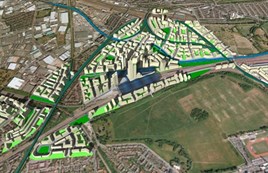And with several platforms at Euston needing to close temporarily, in order to facilitate its redevelopment in preparation for HS2, a plan has been mooted to divert WCML commuter trains between Euston and Tring onto Crossrail.
While it is not within the current scope of Crossrail, it may well be necessary to route these trains into the central section - potentially bringing central London workers closer to their destination, and omitting the need to change at Euston for the increasingly pressured London Underground.
Plans remain at an early stage, although the idea has been on the drawing board for some years, having been mooted in a 2009 Network Rail Route Utilisation Study. It was also given some credibility in March 2014 by HS2 Ltd Chairman Sir David Higgins, when he delivered his first series of recommendations in the HS2 Plus report.
Some of these plans and proposals are, of course, still some years away. But there is one rail-related building at Old Oak Common that has undergone a recent transformation - the Hitachi depot at the North Pole site.
The Transport Secretary owns the former European Passenger Services (Eurostar) depot, which in turn is managed by the DfT-owned London and Continental Railways (which took on a lot of the properties owned by the now defunct British Rail Residuary Board).
North Pole depot was the London depot for Eurostar from 1994 until 2007, sitting adjacent to the GWML between Ealing Broadway and London Paddington on both sides of the West London Line (with which it also has a connection, and which was used for empty passenger stock workings - the Eurostar Class 373s, using a mix of third rail and overhead wiring to make their way to and from Waterloo International).
The depot became redundant and closed in November 2007 as a depot for Eurostar, which switched maintenance to Temple Mills (near Stratford International) when its London terminus changed from Waterloo to St Pancras International.
Hitachi Rail Europe Production Director Jon Veitch tells RAIL that a considerable amount of investment went into the site before he was handed the keys in October 2014 (on time and on budget).
Although the depot had been kept in good order, in Veitch’s words “far more than just a lick of paint” was needed to bring the facility up to Hitachi standards.
By the time the first IEP trains enter service with FGW, the depot will have been operationally closed for nearly ten years.
Veitch does not expect Train 1 (the first Class 800) to arrive at North Pole before this autumn, following the anticipated successful completion of testing at the Old Dalby test track shortly after it arrives in the UK on March 11. However, the two IEP mock-ups used in the design process are already at the depot - a representation of the type of trains that will fill the depot eventually.
When the trains do arrive, they will be met by new fuelling facilities that have been installed on the depot’s arrival roads, as well as watering points and fully automated depot signalling.
There are two new carriage washing machine facilities and a tandem wheel lathe, while a synchronised whole-train lifting system has been installed that is capable of lifting all nine cars. An underframe cleaning facility has also been installed, as has a new connection with the GWML serving the low-numbered platforms at Paddington.
“We can probably take a third of the First Great Western IEP fleet,” says Veitch. “There is a lot of additional capacity, as with Stoke Gifford.”
Veitch says adjacent administration buildings have also been refurbished, with 200 desks for the staff who will be working there. In just a few years, it will once again be a busy operational depot.
While the bulk of the depot has been rejuvenated for the new IEP fleet, there remains a long-term question mark over the rest of the site.
LCR has been directed to keep the remaining facility safe and secure, and to co-operate with proposals for its future use and redevelopment. The company says it is examining residential and commercial uses for the remainder of the site, as well as exploring interim use opportunities - whether that involves a future railway use remains to be seen.
Whatever happens with the specific railway depots and the overall plan for the future Old Oak Common station, it is clear that this historic and important railway site will continue to have a future.
This feature was published in RAIL 767 on February 4 2015













Login to comment
Comments
No comments have been made yet.